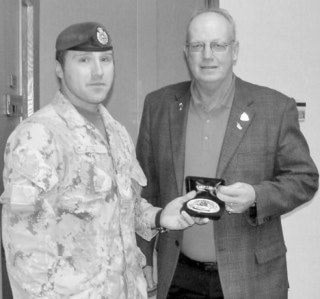By Kim Hutchison
Staff Reporter:
After eight months of serving our country, making a difference and saving lives, Marty Gratrix has returned from Afghanistan.
Gratrix, who has been in the Canadian army for nine years, went on his first overseas mission in 2004/2005 where he did mine disposal, route clearance and patrolling.
Ten months ago he returned and worked as a member of an improvised explosive device disposal (IEDD) team.
To help better understand what Gratrix’s workday involved, an IED is a homemade device usually consisting of an initiation system or fuse, explosive fill, a detonator, a power supply for the detonator and a container. It’s designed to cause death by using explosives alone or in combination with toxic chemicals, biological toxins, or radiological material. It is unique because its builder improvises with available materials meaning it can be produced in various sizes, functioning methods, containers and delivery methods.
One category of IED’s is the package type. These can be thrown from overpasses, emplaced in potholes covered with dirt, planted along alternate supply routes targeting vehicles, command detonated either by wire, or remote device and time-delayed triggered, which can be detonated by a cordless phone from a car. The two other categories are vehicle-borne and suicide IED’s.
The amount of these devices and their range of sophistication make them difficult to detect and diffuse. They are one of the biggest threats facing coalition forces on the battlefields of Afghanistan and are responsible for the greatest numbers of soldier injuries and fatalities.
“You never know what you’re going to encounter.
Continued on Page A3
You do what you have to and hope it [the device] doesn’t set off,” said the modest Gratrix who described his first mission in Afghanistan as “nothing even close to this one.”
“Knowing your saving Canadian lives and the lives of the locals makes it worth the risk.”
What does Gratrix think about the possibility troops pulling out in the year 2011?
“If the Afghanistan National Army is built to the point where it can sustain operations, we should pull out. If not, Canada should stay longer. I’m sure Canadian military leadership will want to leave once the mission in complete,” he said.
Whether or not he will return for a third mission in the future he can’t yet say. One doesn’t know whether he or she will be headed overseas until six to eight months prior to deployment.
Gratrix has been home for two months and said it feels to great to back. On Nov 18. he went to the Ponoka County Council office to receive a belt buckle in recognition of his diligently serving our country and representing our community.
“I’ve never heard of anyone showing as much support as Ponoka,” Gratrex told the Ponoka County Council. “When you’re over there, it makes a difference to know people back home care.”
That we most certainly do.
Congratulations on your success and safe return!
